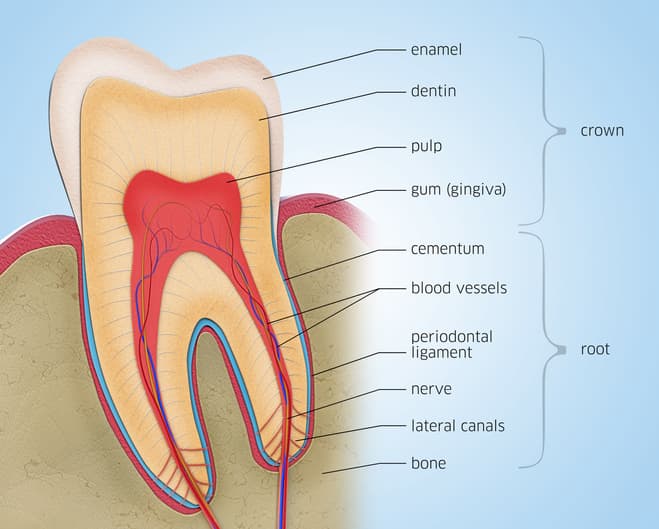 The teeth are one of the hardest substances in the human body. Besides being essential for chewing, the teeth play an important role in speech. Parts of the teeth include:• Enamel: The hardest, white outer part of the tooth. Enamel is mostly made of calcium phosphate, a rock-hard mineral.
The teeth are one of the hardest substances in the human body. Besides being essential for chewing, the teeth play an important role in speech. Parts of the teeth include:• Enamel: The hardest, white outer part of the tooth. Enamel is mostly made of calcium phosphate, a rock-hard mineral.• Dentin: A layer underlying the enamel. It is a hard tissue that contains microscopic tubes. When the enamel is damaged, heat or cold can enter the tooth through these paths and cause sensitivity or pain.
• Pulp: The softer, living inner structure of teeth. Blood vessels and nerves run through the pulp of the teeth.
• Cementum: A layer of connective tissue that binds the roots of the teeth firmly to the gums and jawbone.
• Periodontal ligament: Tissue that helps hold the teeth tightly against the jaw.
• Canines (4 total): The pointed teeth just outside the incisors.
• Premolars (8 total): Teeth between the canines and molars.
• Molars (8 total): Flat teeth in the rear of the mouth, best at grinding food.
• Wisdom teeth or third molars (4 total): These teeth erupt at around age 18, but are often surgically removed to prevent displacement of other teeth.The crown of each tooth projects into the mouth. The root of each tooth descends below the gum line, into the jaw.
Teeth Conditions
- Cavities (caries): Bacteria evade removal by brushing and saliva and can damage the enamel and deeper structures of teeth.
- Tooth decay: A general name for the disease of the teeth, including cavities.
- Periodontitis: Also called gum disease, is a serious gum infection that damages the soft tissue and, without treatment, can destroy the bone that supports your teeth.
- Gingivitis: A form of gum disease. Inflammation of the surface portion of the gums, around and between the crowns of the teeth. Plaque and tartar buildup can lead to gingivitis.
- Plaque: A sticky, colourless film made of bacteria and the substances they secrete. Plaque develops quickly on teeth after eating certain foods but can be easily brushed off.
- Tartar: If plaque is not removed, it mixes with minerals to become tartar, a harder substance. Tartar requires professional cleaning for removal.
- Overbite: The upper teeth protrude significantly over the lower teeth.
- Underbite: The lower teeth protrude significantly past the upper teeth.
- Teeth grinding (bruxism): Stress, anxiety, or sleep disorders can cause teeth grinding, usually during sleep. A dull headache or sore jaw can be symptoms.
- Tooth sensitivity: When one or more teeth become sensitive to hot or cold, it may mean the dentin is exposed.
Teeth Tests
- Teeth X-ray films: X-ray pictures of the teeth may detect cavities.
- Teeth examination: By viewing and accessing the teeth, a dentist can detect potential teeth problems.
Teeth Treatments
- Brushing teeth: Daily brushing of the teeth helps remove plaque and helps prevent cavities.
- Flossing teeth: Using floss or an approved dental gum cleaner help clean teeth below the gum line, where brushing cannot reach.
- Teeth cleaning: Professional teeth cleaning every six months may help prevent or manage teeth and gum disease.
- Tooth filling: To treat a cavity your dentist will remove the decayed portion of the tooth and then “fill” the area on the tooth with either a composite or metal material.
- Root canal: Root canal therapy is a treatment used to repair and save a tooth that is badly decayed or infected.
- Tooth extraction: If a tooth is too damaged to repair with a filling or root canal, it may need to be removed. Wisdom teeth are often extracted to prevent displacement of the other teeth.
- Braces: An artificial device or system that places teeth under tension for a long period of time. Eventually, braces can help crooked teeth become realigned.
- Mouthguard: A plastic mouthpiece can provide protection from teeth grinding and injury during sports.
- Dental sealants: A plastic sealant applied to the teeth can help block bacteria from hiding in crevices on teeth surfaces. Sealants can help prevent cavities.
- Teeth whitening: Over-the-counter and professional chemical treatments can bleach teeth to a brighter white. Tooth sensitivity is the most common side effect.
